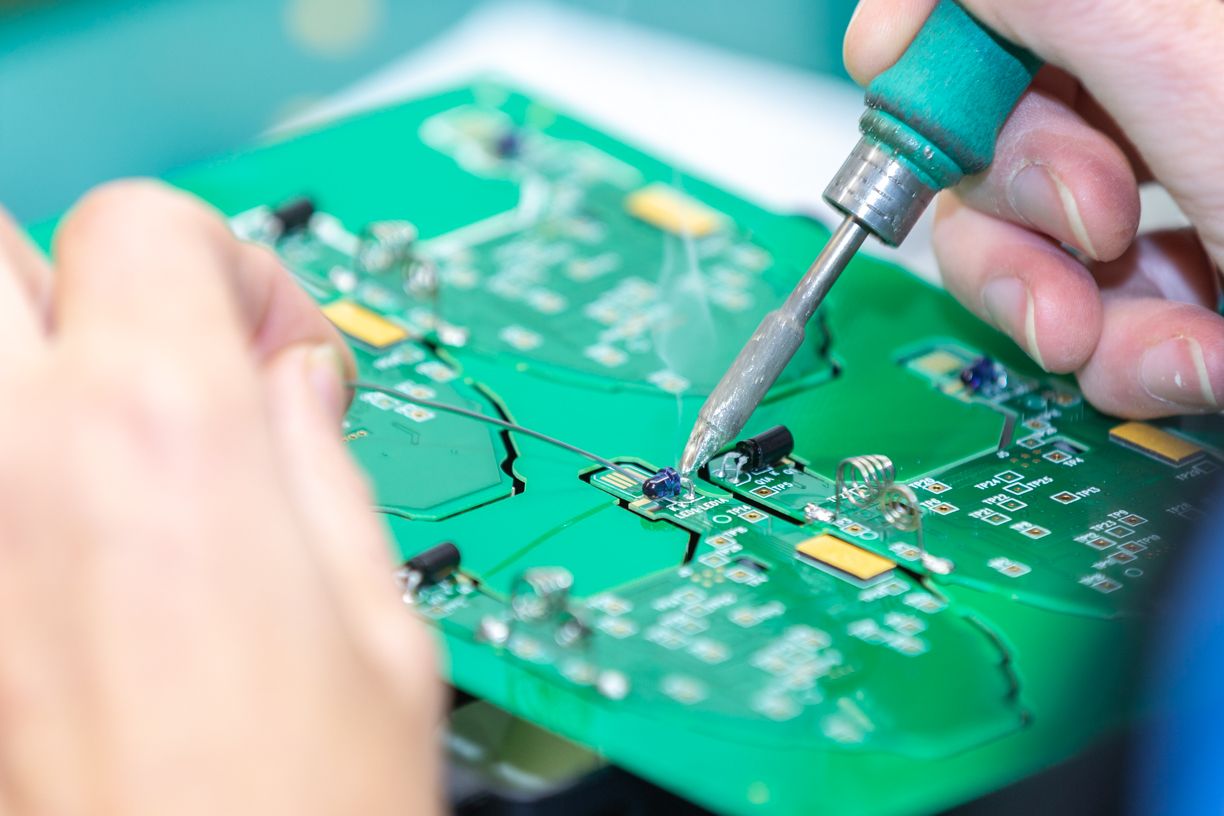PCBs (Printed Circuit Boards) are fundamental components in modern electronics. They serve as the skeletal framework that connects and powers the various electronic components in devices. To ensure optimal performance and reliability in electronic products, their design has to be high-quality.
PCB Design Overview
The PCB design process has three important components.
- Schematic Creation – Designers start by creating a schematic, which is a visual representation of the circuit’s connections and components.
- PCB Layout – This involves transferring the schematic to a physical layout on a computer-aided design (CAD) program. Designers place components and determine the routing of electrical connections.
- Routing and Tracing- Traces are the conductive pathways on the board. Routing involves creating these pathways to connect the components while considering factors like signal integrity, power distribution, and minimizing interference.
Considerations for Quality PCB Design
To determine the quality of any PCB design and assembly, there are a number of factors to consider.
- Component Placement – Strategic placement of components is crucial for optimal functionality and signal integrity. It is important to consider factors like signal paths, thermal management, and ease of assembly.
- Routing and Signal Integrity – Careful routing of traces is essential to minimize interference, crosstalk, and signal degradation. Techniques like impedance control and signal isolation are used to maintain signal integrity.
- Power Distribution and Grounding – Proper distribution of power and efficient grounding are vital for stable performance, reducing noise, and preventing voltage fluctuations.
- Thermal Management – Adequate heat dissipation is essential, especially for high-power components. Designers incorporate heatsinks, thermal vias, or copper pours to manage heat effectively.
- Manufacturability – Designers must consider the PCB’s manufacturability to ensure it can be produced cost-effectively and reliably at scale.
PCB Manufacturing Process
To manufacture PCBs, the process consists of two stages: pre-production and manufacturing.
In pre-production, the steps involved are as follows:
- Materials Selection – Choosing the right substrate material (like FR-4) and copper thickness based on the design’s requirements.
- Panelization – Arranging multiple PCB designs onto a panel for simultaneous manufacturing.
Once in the manufacturing stage, the different steps are as follows:
- Printing – Using a photoresist, the PCB design is printed onto the substrate.
- Etching – Chemical etching removes excess copper, leaving behind the traces and pads according to the design.
- Drilling – Holes for component leads and vias are drilled precisely.
- Plating – Applying a thin layer of copper to ensure conductivity in the drilled holes.
- Solder Mask Application – Protective layer application to prevent short circuits and oxidation while defining solder areas.
- Silkscreen Printing – Labels, identifiers, and component outlines are printed onto the board.
- Testing and Inspection – Boards undergo rigorous testing for functionality and quality assurance.
Ensuring Quality in PCB Design and Manufacturing
The quality of your PCB design and assembly is crucial to its performance. The process has to be overseen by a good PCB contract manufacturer, one that uses the right tools and technologies.
Examples of advanced tools and technologies used are:
- CAD Software – Utilizing advanced CAD tools allows for precise design and simulation, aiding in error detection before manufacturing.
- Design Rule Checking (DRC) – Automated checks to ensure the design meets specific manufacturing requirements and standards.
- Simulation and Prototyping – Simulating the PCB’s behavior and creating prototypes helps identify and resolve potential issues early in the design phase.
A PCB contract manufacturer also has to adhere to the following standards and guidelines:
- IPC Standards – Following industry-standard guidelines set by organizations like IPC ensures quality, reliability, and interoperability of PCBs.
- Regulatory Compliance – Meeting regulatory standards (e.g., RoHS, UL) ensures the safety and environmental friendliness of the final product.
There should also be strong collaboration and communication.
- Cross-Functional Teams – Collaboration between designers, engineers, and manufacturers is crucial to address design challenges and optimize the manufacturing process.
- Clear Documentation – Detailed documentation aids in understanding design intent, reducing errors during manufacturing.
Conducting quality control and assurance is a must too.
- Testing and Inspection – Rigorous testing methods, including automated optical inspection (AOI) and electrical testing, ensure the PCBs meet specifications and performance criteria.
- Feedback Loop – Continuous improvement through feedback from testing and post-production analysis helps refine future designs and manufacturing processes.
ㅤ ㅤ ㅤ ㅤ ㅤ ㅤ ㅤ ㅤ ㅤ ㅤ ㅤ ㅤ ㅤ ㅤ ㅤ ㅤ ㅤ ㅤ ㅤ ㅤ ㅤ ㅤ ㅤ ㅤ ㅤ ㅤ ㅤ ㅤ ㅤ ㅤ ㅤ ㅤ ㅤ ㅤ ㅤ ㅤ ㅤ ㅤ ㅤ ㅤ ㅤ ㅤ ㅤ ㅤ ㅤ ㅤ ㅤ ㅤ ㅤ ㅤ ㅤ ㅤ ㅤ ㅤ ㅤ ㅤ ㅤ ㅤ ㅤ ㅤ ㅤ ㅤ ㅤ ㅤ ㅤ ㅤ ㅤ ㅤ ㅤ ㅤ ㅤ ㅤ ㅤ ㅤ ㅤ ㅤ ㅤ ㅤ ㅤ ㅤ ㅤ ㅤ ㅤ ㅤ ㅤ ㅤ ㅤ ㅤ ㅤ ㅤ ㅤ ㅤ ㅤ ㅤ ㅤ ㅤ ㅤ ㅤ ㅤ ㅤ ㅤ ㅤ ㅤ ㅤ ㅤ ㅤ ㅤ ㅤ ㅤ ㅤ ㅤ ㅤ ㅤ ㅤ ㅤ ㅤ ㅤ ㅤ ㅤ ㅤ ㅤ ㅤ ㅤ ㅤ ㅤ ㅤ ㅤ ㅤ ㅤ ㅤ ㅤ ㅤ ㅤ ㅤ ㅤ ㅤ ㅤ ㅤ ㅤ ㅤ ㅤ ㅤ ㅤ ㅤ ㅤ ㅤ ㅤ ㅤ ㅤ ㅤ ㅤ ㅤ ㅤ ㅤ ㅤ ㅤ ㅤ ㅤ ㅤ ㅤ ㅤ ㅤ ㅤ ㅤ ㅤ ㅤ ㅤ ㅤ ㅤ ㅤ ㅤ ㅤ ㅤ ㅤ ㅤ ㅤ ㅤ ㅤ ㅤ ㅤ ㅤ ㅤ ㅤ ㅤ ㅤ ㅤ ㅤ ㅤ ㅤ ㅤ ㅤ ㅤ ㅤ ㅤ ㅤ ㅤ ㅤ ㅤ ㅤ ㅤ ㅤ ㅤ ㅤ ㅤ ㅤ ㅤ ㅤ ㅤ ㅤ ㅤ ㅤ ㅤ ㅤ ㅤ ㅤ ㅤ ㅤ ㅤ ㅤ ㅤ ㅤ ㅤ ㅤ ㅤ ㅤ ㅤ ㅤ ㅤ ㅤ ㅤ ㅤ ㅤ ㅤ ㅤ ㅤ ㅤ ㅤ ㅤ ㅤ ㅤ ㅤ ㅤ ㅤ ㅤ ㅤ ㅤ ㅤ ㅤ ㅤ ㅤ ㅤ ㅤ ㅤ ㅤ ㅤ ㅤ ㅤ ㅤ ㅤ ㅤ ㅤ ㅤ ㅤ ㅤ ㅤ ㅤ ㅤ ㅤ ㅤ ㅤ ㅤ ㅤ ㅤ ㅤ ㅤ ㅤ ㅤ ㅤ ㅤ ㅤ ㅤ ㅤ ㅤ ㅤ ㅤ ㅤ ㅤ ㅤ ㅤ ㅤ ㅤ ㅤ ㅤ ㅤ ㅤ ㅤ ㅤ ㅤ ㅤ ㅤ ㅤ ㅤ ㅤ ㅤ ㅤ ㅤ ㅤ ㅤ ㅤ ㅤ ㅤ ㅤ ㅤ ㅤ ㅤ ㅤ ㅤ ㅤ ㅤ ㅤ ㅤ ㅤ ㅤ ㅤ ㅤ ㅤ ㅤ ㅤ ㅤ ㅤ ㅤ





